Article contents
Cloning and tissue expression of the adiponectin gene in geese
Published online by Cambridge University Press: 30 October 2009
Abstract
Three pairs of primers were designed for amplification of the adiponectin gene in geese (Anser demeatica) based on the published sequences of chicken, duck and other adiponectin homologues. The complete 1062 bp sequence of the adiponectin gene in geese, obtained by polymerase chain reaction (PCR) amplification and splicing, contained two exons and one intron. The coding sequence was 738 bp long and included codes for 245 amino acids (GenBank Accession No. EU370686). The coding sequence and the corresponding protein of goose adiponectin shared the highest homology with ducks, 94.85% and 95.51%, respectively; homology with chicken adiponectin was next highest, while the lowest homology was to be found with mammals. The predicted molecular weight (MW) and isoelectric point (pI) were 26,603.3 Da and pH 5.19, respectively, which were highly similar to those of species considered above. Reverse transcription-PCR revealed that goose adiponectin mRNA was highly expressed in skeletal muscle, fatty tissue, heart and stomach muscles. Medium levels of expression were detected in the small intestine, stomach glandular tissue, kidney and lung, while it was only weakly expressed in the liver, spleen, ovaries and diencephalon.
- Type
- Review Article
- Information
- Copyright
- Copyright © China Agricultural University 2009
References
- 2
- Cited by


